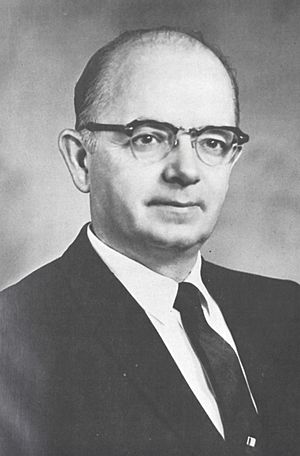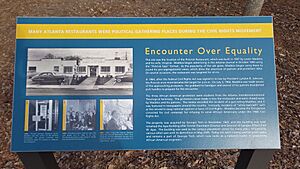Lester Maddox facts for kids
Quick facts for kids
Lester Maddox
|
|
|---|---|
 |
|
| 75th Governor of Georgia | |
| In office January 10, 1967 – January 12, 1971 |
|
| Lieutenant | George T. Smith |
| Preceded by | Carl Sanders |
| Succeeded by | Jimmy Carter |
| 7th Lieutenant Governor of Georgia | |
| In office January 12, 1971 – January 14, 1975 |
|
| Governor | Jimmy Carter |
| Preceded by | George T. Smith |
| Succeeded by | Zell Miller |
| Personal details | |
| Born |
Lester Garfield Maddox
September 30, 1915 Atlanta, Georgia, U.S. |
| Died | June 25, 2003 (aged 87) Atlanta, Georgia, U.S. |
| Resting place | Arlington Memorial Park Sandy Springs, Georgia, U.S. |
| Political party | Democratic |
| Other political affiliations |
American Independent (1968, 1976) |
| Spouse |
Hattie Virginia Cox
(m. 1935; died 1997) |
| Children | 4 |
Lester Garfield Maddox Sr. (born September 30, 1915 – died June 25, 2003) was an American politician. He served as the 75th governor of the U.S. state of Georgia from 1967 to 1971.
Maddox became well-known for his strong support of segregation. This meant keeping people of different races separate. He refused to serve Black customers at his Atlanta restaurant, the Pickrick. This went against the new Civil Rights Act of 1964. Later, he served as lieutenant governor when Jimmy Carter was governor.
Contents
Early Life and Work
Growing Up in Georgia
Lester Maddox was born in Atlanta, Georgia. He was the second of nine children. His father, Dean Garfield Maddox, worked in a steel factory. Lester left school before graduating to help his family earn money. He took many different small jobs, including working in real estate and grocery stores. He later earned his high school diploma through special courses. During World War II, Maddox worked at the Bell Aircraft factory in Marietta, Georgia. There, he helped build the B-29 Superfortress bomber planes.
Starting a Restaurant Business
In 1944, Maddox and his wife, Hattie Virginia Cox, used their savings to open a grocery store and restaurant. They called it Lester's Grill. This business did well, so they bought land near the Georgia Institute of Technology (Georgia Tech) campus. There, they opened the Pickrick Restaurant.
The Pickrick was a family business. Maddox's wife and children all worked there. It was famous for its simple, cheap Southern cuisine, especially its skillet-fried chicken. The restaurant became very successful.
Maddox and Civil Rights
Refusing to Integrate
The Pickrick Restaurant also became a place where Maddox shared his political ideas. He put ads in Atlanta newspapers that showed cartoon chickens talking about daily political issues. After the 1954 Brown v. Board of Education decision, which said that separate schools for Black and white students were illegal, his ads started to talk about segregation.
Maddox did not want to follow the new Civil Rights Act of 1964. This law made segregation illegal in public places like restaurants. He even filed a lawsuit to keep his restaurant segregated. Maddox said he would close his restaurant rather than serve African Americans.
In April 1964, some African American students tried to enter the Pickrick. Maddox met them holding a pickaxe handle. He later leased and then sold the restaurant to employees. This was so he would not have to serve Black customers. He claimed it was about property rights, not about being against Black people. He even built a monument to "private property rights" near the restaurant.

The building was later bought by Georgia Tech in 1965. It was torn down in 2009.
Political Journey
Early Attempts at Office
While owning the Pickrick, Maddox tried twice to become mayor of Atlanta. In 1957, he lost to William B. Hartsfield. Hartsfield had a more balanced view on racial issues. In 1961, Maddox lost to Ivan Allen, Jr.. Allen won because he got almost all the Black votes.
In 1962, Maddox ran for lieutenant governor. He was a Southern Democrat, meaning he supported states' rights and segregation. He lost this election but became more known across Georgia.
Maddox became known as a "Society of Liberty" supporter. He wanted to fight against the federal government. He believed the government was taking away states' rights and giving special protections to minority groups. People saw him as a "populist," meaning he appealed to common people.
The 1966 Governor's Election
In 1966, Maddox ran for governor as a Democrat. At that time, winning the Democratic primary election in Georgia usually meant winning the general election. Maddox won the primary runoff election. He joked that he won without much money or support from politicians. He also mentioned that President Lyndon Johnson, who signed the Civil Rights Act, was his "best campaign manager" because the law made him close his restaurant.
In the main election, Maddox faced Republican Howard "Bo" Callaway. Callaway won the most votes, but not a majority. Under the rules then, the state legislature had to choose the winner. Since Democrats controlled the legislature, Maddox became governor. He was sworn in on January 10, 1967.
Serving as Governor
As governor, Maddox continued to support states' rights and segregation. When Martin Luther King Jr. was assassinated, Maddox did not allow King's body to lie in state at the Georgia state capitol. He said this was due to a rumor of a planned protest. However, King's funeral procession was peaceful. In 1968, Maddox supported George Wallace, another pro-segregation candidate, for president.
Maddox once joked about improving Georgia prisons by saying they needed "a better class of prisoner." His chief of staff was Zell Miller, who later became governor himself.
Achievements as Governor
Despite his strong segregationist views, Maddox made some surprising changes as governor:
- He hired Black employees in state government.
- He appointed the first African American to lead a state department.
- He appointed the first African American agent for the Georgia Bureau of Investigation.
- He integrated lines at Georgia's farmer's markets.
Years later, Republican Benjamin B. Blackburn said Maddox was a "far better governor than his critics will ever admit." He also noted that Maddox's administration was free of corruption and helped the state's economy grow.
Lieutenant Governor Term
Because of Georgia's laws, Maddox could not run for governor again right after his first term. So, he ran for lieutenant governor instead. He won this election at the same time Jimmy Carter became governor. However, Maddox and Carter often disagreed publicly.
Maddox appeared on The Dick Cavett Show in 1970. During the show, he got upset when the host, Dick Cavett, changed a word he used. Maddox walked off the show, but later returned for another appearance where Cavett jokingly walked off.
Maddox tried to become governor again in 1974 but lost in the Democratic primary.
1976 Presidential Election
When Jimmy Carter ran for president in 1976, Maddox ran against him. He was the candidate for the American Independent Party. Maddox received less than 1% of the votes in the election.
Retirement and Later Years
After his political career, Maddox faced financial problems. In 1977, he started a short comedy career with an African American musician named Bobby Lee Fears. Fears had worked as a busboy in Maddox's restaurant. Maddox had helped him get a pardon from prison. They called themselves "The Governor and his Dishwasher." They performed comedy and music, with Maddox playing the harmonica and Fears playing the guitar.
In 1987, Maddox attended a rally in Forsyth County, Georgia. This rally was organized by members of the Ku Klux Klan after protests against racial discrimination.
Maddox made one last attempt to become governor in 1990 but was unsuccessful. He had heart surgery the next year. He remained a public figure in his home area of Cobb County. In 1992 and 1996, he supported Republican Pat Buchanan for president. His last public speech was in 2001 at a conference for the Council of Conservative Citizens. This group is considered by some to be a white supremacist group.
Personal Life and Death
Family Life
In 1935, Maddox married Hattie Virginia Cox. They had a close and loving marriage. His wife supported him through his illnesses and his political and business career.
Passing Away
Lester Maddox died on June 25, 2003. He passed away from complications of pneumonia and prostate cancer after a fall. He and his wife are buried at Arlington Memorial Park in Sandy Springs. Maddox was quite wealthy when he died due to his successful business career.
Legacy and Remembrance
After Maddox's death, Tom Murphy, a former leader in the Georgia House of Representatives, said that Maddox had a reputation as a segregationist. But Murphy added that Maddox claimed he was not, and that he did more for African Americans than any Georgia governor before him.
However, not everyone agrees with this view. The New York Times called him a "strong segregationist" in his obituary. They noted his beliefs that Black people were less intelligent and that integration was a Communist plot. Despite this, the obituary also mentioned that as governor, Maddox "surprised many by hiring and promoting blacks in state government." He also started a program for early release from state prisons.
The Interstate Highway 75 bridge over the Chattahoochee River is named the "Lester and Virginia Maddox Bridge."
See also

